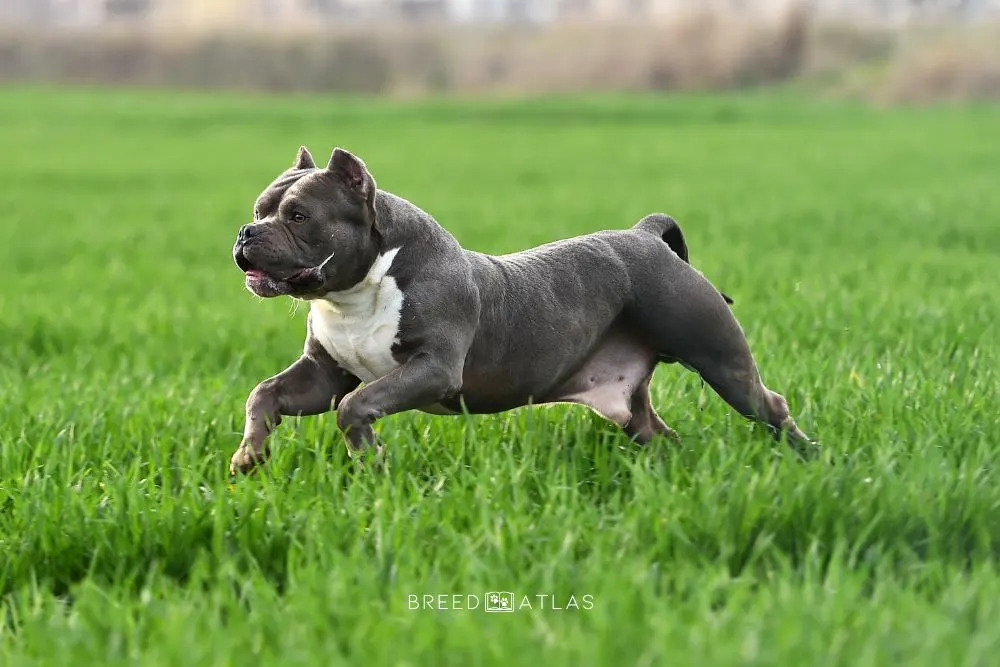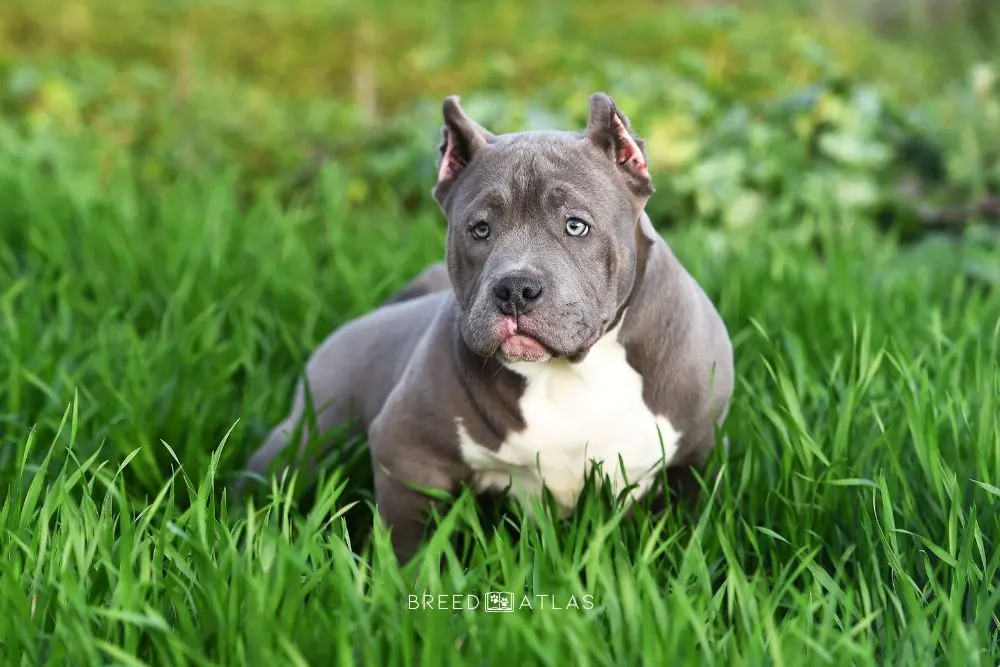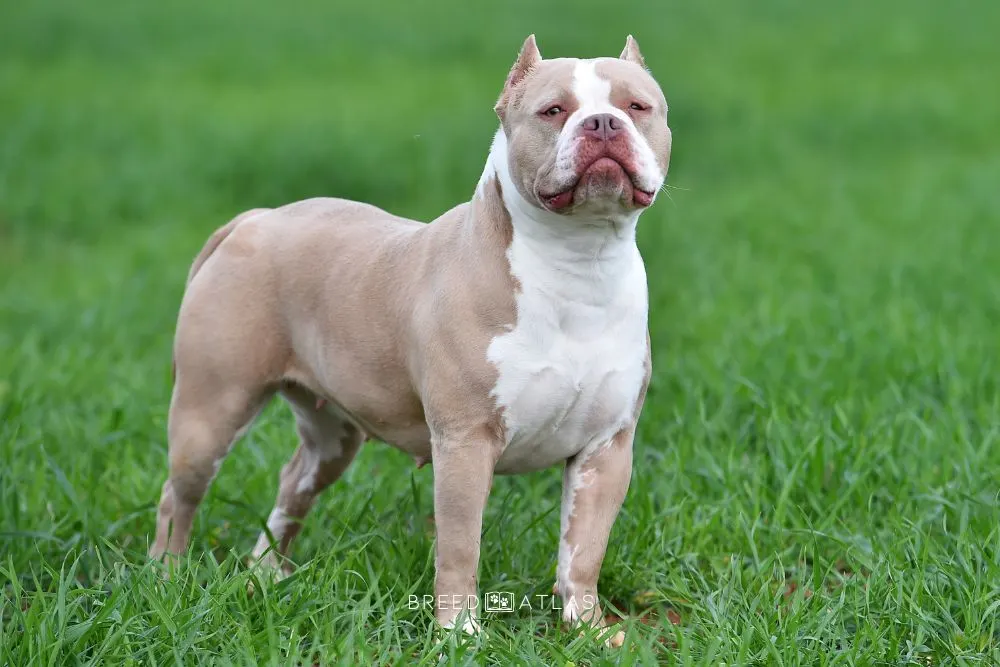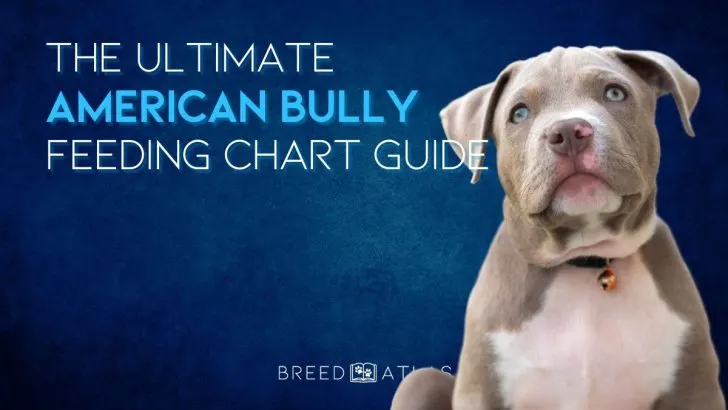Let’s talk about American Bullies and food – not the playground tyrants plotting to steal someone’s lunch, but the muscular, soft-hearted giants that stroll through the dog park with confidence and a gentle demeanor.
Despite their tough exterior, these dogs are extremely loyal companions, always ready to show love and affection to their families. Born from a mix of American Pit Bull Terriers and other bully breeds, American Bullies inherit a distinctive appearance with their broad chests, muscular builds, and friendly smiles.
They come in four main sizes – Pocket, Standard, Classic, and XL. Each size category has its own unique charm, and each has different nutritional needs and feeding schedule.
With that in mind, feeding these magnificent creatures is no small task. This is where our American Bully feeding chart comes into play.
So, let’s get going. We need those Bullies not just well-fed, but perfectly nourished!
Understanding The American Bully Feeding Chart
Now, you might be wondering, “What’s the deal with a dog feeding chart, anyway?” Well, this simple tool guides you through the nutritional needs of your four-legged companion.
An American Bully feeding chart isn’t just about measuring cups of food. It’s a tailored-made feeding programme that helps your pup get the right amount of food, calories, essential vitamins, nutrients, and love in every bite. That said, no one-size-fits-all chart exists — every dog has unique dietary requirements.
American Bullies, with their varied sizes mentioned earlier, require nutritional strategies that cater specifically to their age-related and size-specific needs.
Building on this foundation, it’s important to recognize that the dietary needs of an American Bully are not static. They change as your dog transitions from the playful days of puppyhood through the prime of adulthood and into the serene twilight of their senior years.
Such progression requires a shift in their feeding regimen, where you work on adapting the feeding chart to suit each size category and life stage (and health problems that come with age).
As a dedicated pet parent, it’s your job to delve into research, consult with your veterinarian, and determine the best feeding strategy for your companion.
Consider this your nudge in the right direction!
American Bully Puppy Feeding Chart

Raising an American Bully puppy is a pawesome adventure filled with joy, challenges, and, most importantly, lots of feeding!
As these little bundles of muscle grow, understanding how much do American Bullies puppies need to eat becomes one of the first items on your checklist. Besides that, you also keep in mind that their calorie needs are met for optimal weight gain and development.
Judging by the American Bully growth chart, these dogs, depending on the size category, can become quite a handful!
From their first weeks of age, the right balance of proteins is crucial to support their healthy growth and build the foundation of their muscular physique.
Here is a quick American Bully puppy feeding guide from birth to 12 months of age!
| Puppy Age (Months) | Average Weight Range (lbs/kg) | Feedings Per Day | Cups of Food Per Day |
| Birth-2 | Dependent on mother’s milk | On demand (Mother’s milk/formula) | None until weaning begins |
| 2-4 | 10-20 lbs (4.5-9 kg) | 4 | 1-2 |
| 4-6 | 20-40 lbs (9-181 kg) | 3 | 2-3 |
| 6-12 | 40-60 lbs (18.1-27.2 kg) | 3 | 2.5-4 |
| 12+ | 60-85 lbs (27.2-38.5 kg) | 2 | 2-3 |
Early Nutrition (Birth To 3 Weeks)
In the earliest days, how much food does your American Bully puppy eat? Zero, if we’re talking about anything other than mother’s milk.
Here’s a fun fact for you – the very first milk they receive is called colostrum, a crucial component that kickstarts the pup’s immune system and health.
This natural elixir is packed with the perfect blend of nutrients, amino acids, protein, antibodies, growth factors, white blood cells, immune cells, and essential fats, all crucial for your pup’s initial leap into life.
The weaning comes knocking on the puppies’ door at about 4 to 6 weeks of age. Oh, they grow up so fast! Don’t they?
Weaning Process (3 To 8 Weeks)
As puppies reach the 3-month mark, they begin transitioning from liquid to solid food. In other words, Bully pups gradually shift from a diet exclusively of mother’s milk to nutrient-dense commercial puppy food.
Although making this transition might sound relatively easy, it can be tricky as such a dietary shift may cause stomach problems if not done correctly.
The trick is to slowly mix in solid, high-quality puppy food with a bit of warm water or puppy milk replacer at first. This grub is often called puppy mush, and it truly does not look super-appetizing to us.
However, this gentle method is genius as it lets puppies get used to solid food at their own pace, keeping their tummies happy and avoiding any digestive troubles. From this point, it is not only puppy mush: the pups should get be getting used to three to four smaller dry meals per day (1 cup of feed per day).
The puppies are still ingesting something completely new into their body, which is why they may develop runny stool, stomach pain, and/or changes in appetite. Don’t panic, this is often a thing during the weaning process in all dogs – not just Bullies!
Make sure to monitor the pups if any digestive problems during this phase occur. If in doubt, do not hesitate to contact your vet for advice or health check.
Growing Fast (6 – 12 Months)

By the time these active puppies reach 6 months, they’re little bundles of energy and growing fast, so their diet really needs to keep up! It’s all about giving them the right mix of yummy, high-quality puppy food that fuels their play and supports their growth.
At this stage, consider gradually introducing a wider variety of foods within their diet, if you haven’t already.
So, what’s on the menu for these growing champs? Think quality meats that pack a protein punch for muscle development, omega-rich fish oil for that shiny coat and brain health, and a mix of veggies and whole grains for those complex carbs that keep the energy levels up and running.
This isn’t just about meeting their nutritional needs, but also about keeping mealtime exciting. Imagine having the same meal day in, day out – boring, right?
Go for about 3 smaller meals per day, serving from three to five cups of food in total per day (this will depend on the size and activity level of your pup).
American Bully Adult Dog Feeding Chart
Congratulations, your once small puppy has now entered the big leagues! Hitting the 1-year milestone means your American Bully is ready to turn to adult dog food.
This transition is not as tricky as the weaning process, since your pup is now eating solid food and wet food. However, this period is crucial for maintaining a healthy weight.
Having said that, it is time to switch to adult food – a diet that contains less calories and nutrients when compared to puppy food. This is when the dog feeding schedule shifts to less frequent but nutritionally dense meals.
Each dog is different and the general rule is to feed your adult standard Bully two to three cups per day, split in two meals. However, you might need to adjust this schedule based on the dog’s individual needs.
American Bully Senior Dog Feeding Chart
As our beloved American Bully companions gracefully age, their bodies undergo various changes, including reduced metabolic rate, diminished organ function, and a decline in muscle mass. Naturally, their nutritional needs undergo subtle yet significant shifts, especially if the dog develops age-related medical conditions.
This is why senior dogs require a tailored diet rich in key nutrients to support their changing bodies and maintain optimal health and vitality.
What changes in feed should be made here in contrast to younger days?
For example, protein intake. While this compound still remains crucial for senior dogs (aiding in muscle maintenance and repair), high protein food should be replaced with leaner sources that help prevent excess strain on aging organs, such as the kidneys.
Next, with age often comes a decline in joint health, and American Bullies being prone to conditions such as hip dysplasia doesn’t really help. Senior Bullies may also develop arthritis. Supplements are your go-to here. Start including ingredients like glucosamine and chondroitin sulfate in their diet as these can help maintain joint mobility and ease discomfort associated with skeletal problems.
There is no denying that their metabolism is not as fast as back when they were puppies. This means they’re more prone to weight gain, especially as their activity levels decrease. But don’t worry! By feeding them a balanced diet with carefully controlled portions, we can help prevent obesity.
Avoid feeding them too many snacks now (I know it is hard to resist the senior dog puppy eyes, but it is for their own good).
While there is no general rule and the meal size depends on the size of the dog, we are getting back to the beginning of the feeding chart, feeding senior Bullies around 1 to 1.5 cups of food per day.
How Much Should You Feed An American Bully?

Think less food, more frequently, always steering towards a balanced diet.
The number of cups of food per day varies depending on factors like weight, activity level, and metabolism. A general rule is 1 to 2 cups of food per day, divided into two meals.
This smaller size like the Pocket Bully, typically requires around 1 to 1.5 cups of food per day, split into two meals. On the other hand, large dogs like XL Bullies often require more food, anywhere from 2.5 to 4 cups of food per day, divided into two or more meals.
It is up to you to decide whether you feed them with Bully Max, premium kibble, or the best wet dog food on the market, the aim is to keep them at their peak — muscular, agile, and healthy.
Be careful with feeding them food dense in calories, as you do not want to end up with an overweight American Bully. You ought to balance the number of meals, playtime, and activity to keep them fit and fabulous!
How To Feed An American Bully Puppy
After transitioning to solid puppy food, it’s important to make sure you feed them a balanced diet that continues to provide all the necessary nutrients to fuel their little adventurous spirits and energetic bodies, all while maintaining a healthy weight.
Aim for puppy food that is:
- Packed with protein – to help those muscles grow strong. Look for real meat, like chicken or beef, right at the top of the ingredient list.
- Consists of healthy fatty acids – healthy fats mean more energy for running and playing. Ingredients like fish oil are great for shiny coats and healthy skin, too. We are talking omega 3 and 6 oils! Since Bullies are prone to a plethora of skin problems, this is really important.
- Fueled with carbs – whole grains or veggies provide the carbs they need to keep the energy up and the tummy full.
- Rich in vitamins and minerals – extras like calcium for strong bones, zinc for immune support, vitamin E for skin and coat health and other supplements that have properties to help keep your pup healthy and happy.
Don’t go overboard with feeding your American Bully puppy supplements. Most of the time, complete puppy food already consists of the balanced amount of nutrients needed for dogs at that age. Adding more supplements to their diet may lead to vitamin poisoning and intoxication.
Active puppies might need more fuel, but the goal is a healthy weight, not an overstuffed pup. Definitely avoid free feeding and giving too many snacks. Keep an eye on their weight and make sure they’re not getting too chubby or staying too skinny.
Splitting their daily food into a few smaller meals is a good idea as it helps keep their energy levels steady throughout the day.
How Much Water Should An American Bully Puppy Drink?
Make sure your American Bully puppy always has fresh water to sip on throughout the day. Always keep a bowl of fresh water within their vicinity!
Typically, puppies require roughly half a cup of water every couple of hours.
This can vary from pup to pup. Once they are weaned and start getting older, their water needs adjust to about half an ounce to one ounce per pound of their body weight each day.
Something that is often overlooked is owners giving their dogs cold water. While it is refreshing, it may cause tummy problems in some dogs. Don’t go for ice-cold water.
Not only do they need it to quench their thirst, but drinking fresh water aids in maintaining healthy digestion. I mean, there is no such thing as too much water, is it?
American Bully Raw Diet Yay Or Nay?

At its heart, the raw food, or BARF (Biologically Appropriate Raw Food), diet for dogs aims to replicate what their ancestors would eat in the wild, consisting of raw meats, bones, fruits, and vegetables.
Now, believe it or not, but this is often a heated discussion among all paw lovers, especially those that own large dogs.
Deciding on whether to feed your American Bully a raw diet can feel like going through a maze of advice, with strong opinions on all sides.
I understand the deep desire to provide the best for our furry family members. Feeding my dog, I’ve pondered over raw dog food, considering its benefits and potential health issues. It’s a decision that shouldn’t be taken lightly, as a raw diet can significantly impact your American Bully’s health and happiness.
Anyway, I can provide you with some pros and cons, but in the end, it is up to you and your vet to decide what is best suited for your Bully.
The Pros
There’s good reason to consider a raw diet: many advocates report improved coat health, better dental hygiene, and more energy among the benefits.
Supporters also believe that raw feeding leads to higher energy levels and leaner body mass, helping dogs maintain a healthy weight and build muscle more effectively.
These benefits can be quite appealing for the development and maintenance of the robust, muscular physique characteristic of American Bullies during their formative months.
The Cons
The biggest downside are the potential for nutritional imbalances, the risk of bacterial contamination, and parasite infestation which could lead to health issues.
In a limited-scale research study examining client-owned canines, it was found that a significant majority of raw chicken-based diets (80%) tested positive for the presence of Salmonella serovars.
In contrast, none of the samples from commercial dry dog food formulations showed any signs of contamination with Salmonella.
Besides these invisible pathogens, the bones in raw food may pose a choking hazard, getting stuck in the digestive tract or in some cases, sharp bone edges penetrating the intestinal mucosa.
The best approach? Do your homework. Consult with a veterinarian or a canine nutritionist who understands the unique needs of your American Bully. Remember, what works for one dog might not be the best for another.
What To Feed My Bully To Gain Weight?
A big part of your American Bully’s weight is genetics. If your puppy has skinnier parents, it’s likely he’ll never gain muscle mass as a Bully who comes from a bloodline with lots of muscular dogs.
However, if you wish to help your Bully gain weight in a healthy way, make sure to give him lots of protein.
Enriching his diet with foods such as pumpkin, sweet potato, and rice, as well as providing him with the right amount of exercise, can do wonders for his muscle mass.
There are certain supplements you can buy that will help your dog gain weight, as well.
Just remember, overfeeding your dog will only lead to obesity, and forcing him to exercise too much can lead to numerous joint and bone problems.
Balance is the key, and building muscle mass takes time, especially if your pup is still young.
Final Thoughts
When you look at the American Bully feed chart, remember, the heart of the matter is simple: giving your furry pal a diet that’s as nutritious and full of love as your relationship with them.
Bottom line is making sure you provide a balanced, nutritious diet tailored to your doggo’s specific needs, age, and activity level.
It’s all about feeding them with high-quality ingredients and a whole lot of heart. That is easy, right?
Finding the best brand of food out there and offering your Bully a variety of healthy meals is not only going to make them healthy, but it will make your bond all the more special. I mean, who doesn’t enjoy eating a yummy and comforting meal?
Keep an eye on how they’re doing, always be ready to discuss and/or modify things with advice from your vet, and remember, the happiest pups are those who are not just well-fed but also deeply loved.

Meet Iram, a devoted veterinarian, passionate dog lover, and current Ph.D. candidate at Utrecht University in the Netherlands. Seamlessly blending her roles as a vet and content writer, Iram channels her love for dogs into heartfelt narratives.
Since childhood, Iram nurtured a dream of becoming a vet, a passion that runs deep in her family. Having now fulfilled that dream, she’s eager to share her acquired knowledge. In her writing, Iram not only explores the emotional bond between humans and their canine friends but also integrates her veterinary expertise, offering readers a holistic understanding of their beloved pets.
